Bring on the fire!
Welcome to the world of “Las Fallas de Valencia,” a festival so vibrant and unique that it has been declared a Cultural Heritage of Humanity by UNESCO. We are ready to guide you through everything you need to know about this incredible Valencian festival, from its rich history and traditions to practical tips for experiencing it firsthand. Get ready to be immersed in the spectacular fireworks, colorful parades, and mountains of fire that define this one-of-a-kind celebration in Valencia, Spain.
What is Las Fallas de Valencia?
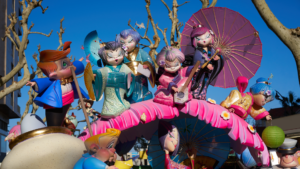
Las Fallas de Valencia is an annual week-long festival, celebrated from March 15th to March 19th, with festivities beginning as early as March 1st. This festival is renowned for its elaborate sculptures made of wood and paper mache, known as “fallas,” which are displayed throughout the city. Each day is marked by spectacular fireworks displays and vibrant parades. Finally, the festival culminates in a grand finale where the fallas are burned during “La Cremá.”
Why is Las Fallas de Valencia Celebrated?
The festival’s origins trace back to the Middle Ages. Carpenters in Valencia used to burn wooden scraps and workshops on the Feast Day of Saint Joseph, their patron saint. This tradition evolved into creating large-scale wooden figures, which were eventually set on fire. Today, Las Fallas is not just a celebration of history but a symbol of rebirth and renewal. It also marks the end of winter and the arrival of spring.
Key Traditions of Las Fallas
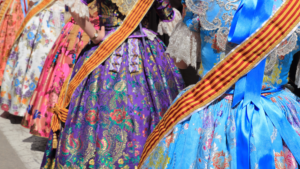
- La Cremá (The Burning): The climax of Las Fallas, La Cremá, occurs on March 19th. This is when the fallas sculptures are set ablaze. These towering artworks, sometimes reaching 30 feet, represent a year’s worth of craftsmanship and are burned in a spectacular display of light and heat.
- La Nit del Foc (The Night of Fire): On the night of March 18th, Valencia witnesses its largest and longest fireworks display. Thousands of fireworks illuminate the sky in a mesmerizing show of color and sound.
- Mascletà: The Mascletà is a daily explosive event in Plaza del Ayuntamiento. Featuring a rhythmic barrage of firecrackers, the sound of the Mascletàs resonates throughout the whole city. Mascletàs begin in early March and continue all the way through the weekend of Las Fallas.
- La Ofrenda de Flores (Flower Offering): On March 17th and 18th, a deeply emotional tradition unfolds as Valencians dressed in traditional attire offer flowers to a massive statue of the Virgin Mary.
Construction of the Fallas
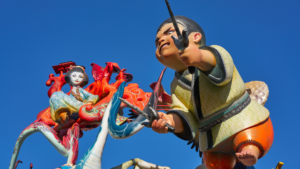
Material and Creation
The fallas are elaborate sculptures made primarily of wood and paper mache. These materials are chosen for their versatility and flammability, as the sculptures are eventually burned during La Cremá.
Themes and Artisans
Themes for the fallas are often satirical or humorous, reflecting current social and political issues. Artists and craftsmen known as “falleros” spend an entire year planning, designing, and constructing these sculptures. The process involves a combination of artistic vision and skilled craftsmanship. The falleros focus on both aesthetic appeal and the ability to convey a message through their artwork. There is a prize for the best falla each year, which acts as a symbol of great pride for the neighborhood that collaborated in its construction.
Community Involvement
The construction of fallas is a community effort, with different neighborhoods in Valencia forming committees to fundraise and collaborate on their local falla. These committees, known as “Casal Faller,” play a vital role in maintaining the tradition and ensuring the success of each sculpture.
The creation and display of the fallas represent a unique blend of art, culture, and community spirit. They are the true cornerstone of Las Fallas de Valencia.
Mascletàs During Las Fallas de Valencia
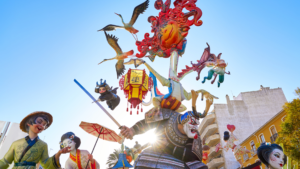
A March Filled with Mascletàs
Mascletàs are a crucial part of the Las Fallas de Valencia celebrations, occurring daily throughout March. Starting on March 1st, these explosive displays are held in the Plaza del Ayuntamiento and are known for their intense sound. Each mascletà combines fireworks and firecrackers, creating an extremely audibly powerful experience. The goal is to produce a rhythmic and intense auditory experience, sometimes reaching up to 120 decibels. Needless to say, they can be felt just as much as heard.
When is Las Fallas de Valencia Celebrated?
Las Fallas takes place annually from March 15th to March 19th in Valencia, Spain. However, the excitement builds up from March 1st, setting the stage for the main events.
Things to Know & How to Prepare
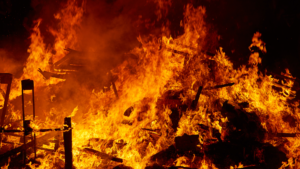
- Timing: Plan to arrive in Valencia a few days before March 15th to experience the full range of festivities.
- Accommodation: Book your accommodation well in advance, as the festival attracts millions of visitors.
- Transportation: Utilize public transportation, as the city center is often crowded and closed to traffic. Budget in extra travel time for anywhere you need to go.
- Safety: Be mindful of your surroundings, especially during large gatherings and firework displays. Las Fallas de Valencia attracts visitors from all over the world, making it a popular place for pickpockets.
- Cultural Respect: Embrace the traditions, participate in the celebrations, and respect the local customs and artwork.
- Explosives: Las Fallas de Valencia is a spectacular display of pyrotechnics, ranging from the grandeur of massive Mascletàs to the playful crackle of street-level petardos. Prepare yourself for a weekend filled with the sparks, pops and earth-shaking booms.
- A City That Never Sleeps: Embrace the nonstop excitement of Las Fallas. Expect sounds, from music to fireworks to joyous shouting, to fill the streets late into the night…and don’t expect to sleep too much!
Want to read more about Valencia?
- Everything to Know about Valencia, Spain
- How to Get a Visa in Spain
- A Guide to La Tomatina in Buñol, Valencia
- The Best Brunch Spots in Valencia
Photo Credits:
- All photos used through Canva Free Media License